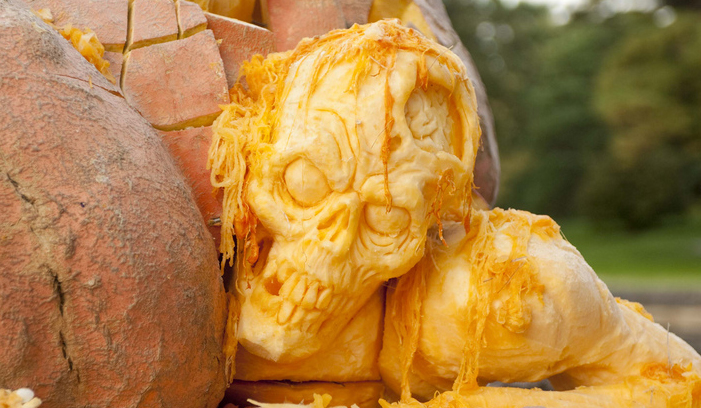Trick-or-Turnip!
Posted in Around the Garden on October 25 2012, by Matt Newman
 Elbow deep in a mound of pumpkin guts, wrenching out the last of that stringy pulp you’ll spend the next day fishing out of your hair? Probably not the best time to ponder the history of the jack o’ lantern. But once your squashy horror is grinning from your porch, peering out the kitchen window, or waiting for some hooligan or other to smash it on the driveway, take a moment and think: who actually came up with this bizarre Halloween tradition? While the NYBG is rolling out its own orange horrors courtesy of Ray Villafane, carving out this story means hopping a boat across the Atlantic to greener pastures, a place older and somewhat more partial to ghost stories (and dark, delicious stouts) than the United States.
Elbow deep in a mound of pumpkin guts, wrenching out the last of that stringy pulp you’ll spend the next day fishing out of your hair? Probably not the best time to ponder the history of the jack o’ lantern. But once your squashy horror is grinning from your porch, peering out the kitchen window, or waiting for some hooligan or other to smash it on the driveway, take a moment and think: who actually came up with this bizarre Halloween tradition? While the NYBG is rolling out its own orange horrors courtesy of Ray Villafane, carving out this story means hopping a boat across the Atlantic to greener pastures, a place older and somewhat more partial to ghost stories (and dark, delicious stouts) than the United States.
If you guessed Ireland, you’ve got the pumpkin pegged. Or should I say turnip? As historical records tell it (there are still plenty of arguments on who inspired what), the holiday tradition of carving up starchy vegetables dates back generations in Ireland. But there was no train of cargo ships itching to haul the North American pumpkin to the shores of the Emerald Isle, as I’m sure you can gather. Instead, the Irish hollowed out their local root vegetables, adorned them with frightful faces, and lit them with embers or candles, a fall tradition brought out during Samhain–or “Sawin,” a fanciful celebration to mark the end of the fall harvest and the beginning of winter in the British Isles.

The purpose of these veg’ heads is debatable, and plenty of experts are willing to chime in. Some say they lit the way for partygoers wandering after dark, others that the turnips would ward off spirits thought to come out of the woodwork during Samhain. Whatever the case, the classic concept of the heads themselves seems to have come about through the intermingling of several tales–both factual and folkloric–from the bogs and bars of the Irish countryside, influencing the look, moniker, and memorable grins of these iconic autumn tricksters.
As spooky, glowing orbs go, Ireland might have the market cornered. Tales of the will-o’-the-wisp (a.k.a. ignis fatuus, or “foolish fire”) have been spun for centuries, describing a ghostly ball of light hovering above swamps after dark, luring curious onlookers but always just out of reach. These “spirits” were also called “jack o’ lanterns,” as they took on the appearance of a nightwatchman–or “Jack of the lantern” in classic Irish vernacular–passing through the mist with his lamp. But there’s another story to back up the name, one with a bit more punch behind it that I can’t help but pass along. For that, we look to a pub tale about a guy named…well, what else?

First printed in the 18th century, the legend tells the story of an Irish blacksmith by the name of Jack (or “Stingy Jack”)–equal parts thief, drunkard, and all-star scoundrel of a barfly–who finds himself alone in the pour house one fateful October evening with none other than the Devil at his side. And, being the Devil, his barmate has no qualms with snatching Jack’s soul right then and there. But as any good Charlie Daniels song will tell you, the Devil is always looking to make a deal. The quick-thinking if completely sloshed Jack offers to give up his soul in exchange for one last glass of tipple, to which the Devil obliges by turning into a coin. Without missing a beat, Jack snatches up the barman’s pay and traps the Devil in his coin purse with a silver cross, refusing to let him out until he agrees he’ll never take the drunkard’s soul.
Years pass, and Jack inevitably shuffles off this mortal coil from old age or drink, only to find himself turned away from heaven for his lying and cheating. Thus he turns to the Devil, who, to Jack’s chagrin, is keeping his promise–hell won’t have the man’s soul either. “But where will I go?” Jack asks. “Back where you came from,” says the Devil, tossing him an ember to light the way. So Jack places the coal in a turnip he’d been eating and returns to the countryside, only to wander for eternity with his makeshift lantern in hand. And while there are different lengths and variations of the story floating around, there you have your “Jack of the Lantern.”

With the Irish potato famine of the 19th century came a mass exodus that carried hundreds of thousands of Irish nationals through Ellis Island and into the United States, and with them came generations of tradition and folklore, their turnip lanterns included. But turnips being somewhat less common in the U.S. than they were in Ireland, something else would have to suffice for the October celebrations. Something a bit bulkier and easier to carve–like the common, North American pumpkin. In time, the tradition took root in popular American culture, and we came to call these tricky, grinning pumpkins as we know them today.
Personally, I think the switch is a welcome one. I can’t imagine trying to explain to trick-or-treaters why your porch is populated with little root vegetable heads.
Each Halloween, the Haunted Pumpkin Garden springs up at the NYBG to celebrate this unmissable tradition, not to mention sweets, ghouls, ghosts in various degrees of spookiness, and at least one gang of roughed-up and ravenous pumpkin patch zombies. Through October 31, join us for all the fun and fright that fall in New York can muster, and bring your kids! We’ll be holding Spooky Nighttime Adventures this weekend to make up for the fact that Halloween is on a Wednesday, so get your tickets here and don your costumes for a rare night out in the Garden.
Header, non-terrifying turnip, and terrifying turnip images courtesy of Wikimedia Commons.

